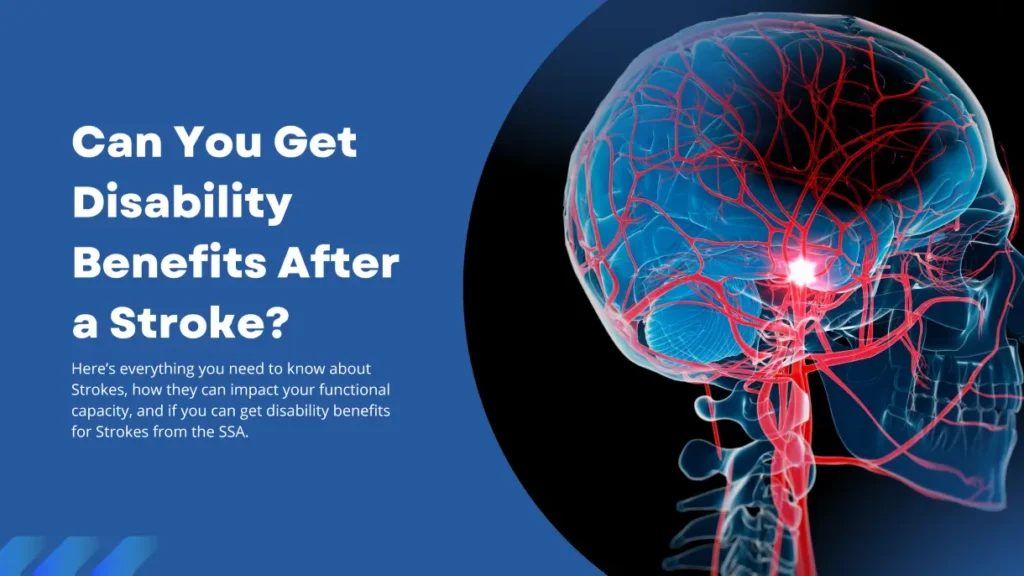Experiencing a stroke can be life-altering, leaving individuals and their families facing significant physical, emotional, and financial challenges. While a stroke itself does not automatically qualify for disability benefits, applicants can get benefits if they demonstrate their inability to work for at least 12 months due to persistent symptoms, backed by medical evidence. Understanding whether a stroke qualifies for SSA disability benefits is crucial for many stroke survivors.
Ready to see if you may qualify? Click here to get a FREE, no-obligation consultation before starting your claim.
Getting Social Security Disability After a Stroke: Key Takeaways
- Financial eligibility for SSDI or SSI is required: To qualify for SSDI, you must have paid sufficient Social Security taxes. For SSI, it’s based on income and assets. In both cases, you need to earn less than $1,550 per month to be eligible.
- Stroke must cause significant limitations for at least one year: The condition must prevent substantial work activities for a minimum of 12 months.
- Meeting SSA Blue Book listing 11.04 or proving inability to work is essential: Stroke symptoms must match SSA’s strict criteria or demonstrate that work is not possible.
- Application can be filed online, by phone, or in-person, with legal help recommended: Choose the most convenient method, and consider a Social Security disability attorney for guidance. An attorney can navigate the complexities of the application process and gather necessary medical evidence to support your claim.
What are Strokes? Symptoms and Side Effects
A stroke occurs when bloodflow to the brain is stopped or reduced, typically due to a blocked blood vessel or cranial hemorrhage, causing significant brain damage. An ischemic stroke is the most common type, characterized by blood clots or plaque that restrict blood flow to the brain. Symptoms vary widely but often include difficulty speaking, maintaining balance, and vision problems.
Some stroke survivors may fully recover, while others experience severe physical and mental limitations, such as paralysis, cognitive impairments, and emotional challenges. The severity of these stroke symptoms and their lasting impact can significantly affect daily living and work capability, making understanding them crucial for evaluating disability eligibility.
Disability Criteria From the SSA
The Social Security Administration (SSA) uses specific criteria to determine eligibility for disability benefits. Firstly, you must meet financial requirements: SSDI is based on your work history and Social Security taxes paid, while SSI depends on income and assets. However, for both SSI and SSDI, the medical condition must be severe enough to prevent substantial gainful activity for at least one year. The SSA evaluates claims using the Blue Book, which lists impairments and criteria for each. Even if your condition isn’t listed, you can still qualify by proving that your limitations prevent any substantial work.
If you do not meet the strict criteria, you may still qualify for benefits through a medical vocational allowance, which assesses your residual functional capacity (RFC) and other factors like medical conditions, age, education, and job skills to determine if you can engage in any gainful employment despite your limitations.
Does the SSA Consider a Stroke a Disability?
The SSA considers a stroke a disability if it meets specific criteria outlined in the Blue Book listing 11.04. A stroke is classified as a disability if it results in lasting impairments, according to SSA guidelines. This includes significant limitations in communication, motor function, or marked physical and mental impairments. These limitations must persist for at least three months post-stroke. If your stroke-related impairments are severe and long-lasting, you may qualify for disability benefits under these guidelines. Proving that your condition meets or equals these criteria is crucial for approval.
SSA Disability Requirements for Neurological Disorders
The SSA’s Blue Book listing 11.04 outlines the criteria for neurological disorders, including strokes. A severe stroke can result in various impairments, such as cognitive deficits and personality changes, which are crucial for determining eligibility for disability benefits. To qualify, you must have one of the following:
- Sensory or Motor Aphasia: Inability to communicate effectively due to brain damage affecting language centers.
- Disorganization of Motor Function: Significant difficulty in controlling two extremities, impacting walking, standing, or using arms.
- Marked Physical and Mental Limitations: Severe difficulties in areas like understanding information, interacting with others, concentrating, or adapting to changes.
These conditions must persist for at least three months post-stroke to qualify.
Does Your RFC Mean There’s No Work You Can Do?
Residual Functional Capacity (RFC) assesses what activities you can still perform despite your limitations. The SSA reviews your medical records, daily activities, and doctors’ opinions to determine your RFC. If your RFC shows you can’t do your past work or any other work due to significant limitations, you may qualify for disability benefits. This assessment considers physical and mental functioning, including physical abilities, mental functions, and the need for frequent rest or assistive devices. Demonstrating severe restrictions through your RFC is crucial for approval.
How Hard Is It to Get Disability for Strokes?
Obtaining disability benefits for a stroke can be challenging due to stringent SSA criteria. Stroke victims often face significant challenges in proving the extent and duration of their impairments. You must demonstrate that your condition severely limits your ability to work for at least one year. Detailed medical documentation is essential to prove the extent and duration of your impairments. Consistency in medical records and the severity of symptoms play a crucial role. Despite the hurdles, understanding the requirements and preparing thoroughly can improve your chances of approval.
Which Stroke Symptoms Might Limit Your Ability to Work?
Stroke symptoms can significantly impact your ability to work. Physical limitations include motor function issues, balance problems, and vision impairments. Mental functioning, including concentration and memory, is crucial for assessing disability. Cognitive difficulties such as memory loss, trouble concentrating, and understanding instructions are common. Emotional challenges, including depression, anxiety, and mood swings, can further complicate work capabilities. These symptoms vary in severity but often require comprehensive medical documentation to prove their impact on your ability to perform job-related tasks. Demonstrating how these symptoms limit daily activities is crucial for a successful disability claim.
Other Medical Conditions & Comorbitites That May Help You Get Disability for Stroke
Having additional medical conditions that commonly occur with strokes can significantly strengthen your disability claim. Transient ischemic attacks (TIAs) serve as warning signs, indicating an increased risk of suffering a major stroke in the future. Conditions such as hypertension, diabetes, atrial fibrillation, high cholesterol, and previous transient ischemic attacks (TIAs) often accompany strokes and can exacerbate the limitations caused by a stroke.
These comorbidities can provide a more comprehensive picture of your overall health, illustrating a greater degree of impairment. The SSA considers the combined impact of these conditions on your daily functioning and work capacity, making thorough documentation essential. Evidence showing how these conditions interact and worsen each other can bolster your case for disability benefits.
Medical Evidence You’ll Need for Your Stroke Disability Claim
Comprehensive medical evidence is crucial for a successful stroke disability claim. Stroke patients must meet specific criteria for securing disability claims, including providing comprehensive medical documentation. This includes detailed medical records, test results, and documentation of your limitations over time. Here’s what you need in order to support your Stroke disability claim.
Medical Records
Collect all relevant medical records, including doctor’s notes, treatment history, and hospital records. These documents should clearly describe the stroke’s impact on your daily life, prognosis, and any ongoing treatments. Detailed descriptions of physical, cognitive, and emotional symptoms, along with prescribed medications and their effects, are vital. Including statements from healthcare providers about your limitations and the need for continued care can strengthen your case.
Medical Evidence
Provide thorough test results, imaging studies such as MRIs or CT scans, and specialist reports. Detailed documentation of ongoing symptoms and treatment plans will strengthen your case. Evidence of rehabilitation efforts, such as physical therapy progress notes, speech therapy reports, and occupational therapy assessments, can highlight the severity and persistence of your impairments. Including functional assessments that show your ability to perform daily activities and work-related tasks is also beneficial.
Evidence that Work Triggers Your Symptoms
Submit proof that job-related stress or physical demands exacerbate your stroke symptoms. This can include statements from employers or vocational experts detailing how your condition impacts your work performance. It is important to document specific work tasks that trigger or worsen symptoms, along with evidence of any accommodations attempted and their ineffectiveness. Personal journals or logs that record the frequency and severity of symptoms in relation to work activities can provide additional support.
Proof of Other Conditions
Include documentation of comorbidities, such as hypertension, diabetes, atrial fibrillation, or high cholesterol, affecting your overall health. These records should demonstrate the combined impact on your daily living and work capability. Medical evidence showing how these conditions interact with stroke symptoms to worsen your overall health can be persuasive. Reports from specialists who treat these comorbid conditions, along with treatment plans and prognoses, can help build a comprehensive picture of your health challenges.
How to Apply for Stroke Disability Benefits
Applying for disability benefits involves several steps to ensure your claim is thoroughly evaluated. The process can be initiated online, by phone, or in person. Working with a disability lawyer can improve your approval odds.
Applying for Social Security Disability Insurance (SSDI) For Stroke Symptoms
To apply for SSDI, you must have worked and paid Social Security taxes for enough years to earn sufficient work credits. In 2025, one work credit is earned for every $1,810 in wages, with a maximum of four credits per year. The number of credits needed depends on your age at the time of disability, but the default requirement is 40 credits, 20 of which need to have been earned in the past 10 years.
Benefits vary but pay an average of around $1,580 per month, with a maximum of $4,018.
Start the application online on the SSA website, call the SSA office, or visit a local Social Security field office. Collect all necessary documentation, including detailed medical records, employment history, and personal identification. Detailed descriptions of your stroke symptoms, treatments, and work limitations are critical. Consider seeking assistance from a disability lawyer to improve your application’s accuracy and completeness.
Applying for Supplemental Security Income (SSI) For Stroke Symptoms
SSI is a needs-based program for individuals with limited income and resources. As of 2025, the federal benefit rate is $967 per month for individuals and $1,450 for couples, though state supplements may apply. To qualify, your countable income must be below the federal benefit rate, and resources must not exceed $2,000 for individuals or $3,000 for couples.
Apply online through the SSA website, by calling the SSA office, or by visiting a local field office. Provide detailed financial information, including income, assets, and living arrangements, alongside comprehensive medical records and documentation of your stroke-related limitations. Proof of citizenship or eligible non-citizen status is also required.
The application process can be complex, and accurate, thorough documentation is essential. Assistance from a disability advocate or lawyer can help navigate the requirements and strengthen your application.
Work With a Disability Lawyer to Improve Your Odds of Approval
Navigating the disability benefits application process can be complex and challenging. Working with a disability lawyer can significantly improve your chances of approval. A disability lawyer can help secure Social Security disability benefits by ensuring the application is thorough and accurate. Lawyers specializing in disability claims understand the SSA’s requirements and can help ensure your application is thorough and accurate.
They can assist in gathering detailed medical evidence, meeting deadlines, and representing you during appeals if necessary. Many disability lawyers work on a contingency fee basis, meaning they only get paid if you win your case, making their services accessible and beneficial.
Ready to see if you may qualify? Click here to get a FREE, no-obligation consultation before starting your claim.

